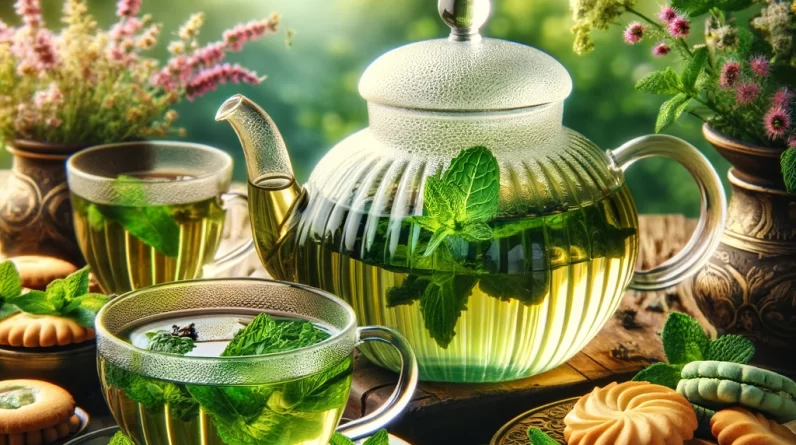
Sage tea, with its unique blend of aromatic flavors and a long history steeped in tradition, stands as a testament to the rich tapestry of herbal teas enjoyed around the world. This blog post delves deep into the essence of sage tea, exploring its origins, health benefits, and the many ways it can be enjoyed. Whether you’re a tea aficionado or new to the world of herbal teas, this guide offers something for everyone, from brewing the perfect cup to discovering delicious pairings that enhance your tea-drinking experience.
Table of Contents
- Introduction
- The Origins and History of Sage Tea
- What Makes Sage Tea Special?
- Brewing the Perfect Cup
- Ways to Enjoy Sage Tea
- The Best Pairings for Sage Tea
- Where to Find and How to Store Sage Tea
- Cultivation and Processing of Sage for Tea
- Conclusion
Introduction
Sage tea, known for its soothing properties and distinctive taste, has been a beloved beverage for centuries. Originating from the Mediterranean region, this herbal tea is made from the leaves of the sage plant, a shrub belonging to the mint family. Sage tea is not only cherished for its flavor but also for its health benefits, including improving digestion and reducing inflammation. This guide will explore the rich tapestry of sage tea, from its historical roots to modern-day enjoyment.
The Origins and History of Sage Tea
Sage tea’s journey begins in the Mediterranean, where it was revered by ancient civilizations for its medicinal properties. The Romans considered sage a sacred herb, using it in rituals and for its health benefits. As trade routes expanded, sage tea found its way across continents, becoming integral to various cultural ceremonies and daily routines. Its popularity has endured, thanks to its versatility and the ease with which it can be cultivated in home gardens.
What Makes Sage Tea Special?
What sets sage tea apart from other herbal teas is its complex flavor profile— a harmonious blend of slightly peppery, minty, and lemony notes. This tea is rich in essential oils, vitamins, and minerals, contributing to its health-promoting properties. Sage tea is especially known for containing rosmarinic acid, a compound with strong antioxidant and anti-inflammatory effects. Its distinct flavor and health benefits make sage tea a unique addition to any tea lover’s collection.
Brewing the Perfect Cup
To brew the perfect cup of sage tea, you’ll need:
- Fresh or dried sage leaves
- Boiling water
- Optional: honey, lemon, or mint for flavor
Steps:
- Place 1-2 tablespoons of fresh sage leaves (or 1 teaspoon of dried sage) in a teapot.
- Pour boiling water over the leaves and steep for 5-10 minutes, depending on the desired strength.
- Strain the leaves and serve. Add honey, lemon, or mint if desired.
Tips:
- Use fresh leaves for a more delicate flavor or dried leaves for convenience.
- Avoid over-steeping to prevent a bitter taste.
Ways to Enjoy Sage Tea
Sage tea can be enjoyed in various ways, making it a versatile choice for any occasion. Here are a few ideas to get you started:
- As a soothing hot beverage: Enjoy sage tea on its own or with a dash of honey for a comforting drink.
- Cold-brewed sage tea: Steep sage leaves in cold water for several hours for a refreshing cold tea.
- Sage tea blends: Mix sage leaves with other herbs like mint or lemon balm for a custom blend.
- In culinary recipes: Use brewed sage tea as a base for soups, stews, or sauces to add depth of flavor.
The Best Pairings for Sage Tea
Sage tea pairs well with a variety of foods, enhancing both sweet and savory dishes. Consider the following pairings for a delightful tea experience:
- With cheese: Sage tea’s earthy flavor complements the richness of cheeses like goat cheese or gouda.
- Fruit desserts: Pair sage tea with apple or pear desserts for a balanced taste.
- Grilled vegetables: Enjoy sage tea alongside grilled vegetables for an herbal touch.
Where to Find and How to Store Sage Tea
Sage tea can be found in health food stores, tea shops, and online. When selecting sage tea, look for organic options to ensure quality. Store sage tea in a cool, dry place, away from direct sunlight, to maintain its flavor and potency. Fresh sage leaves can be dried at home and stored in airtight containers for use throughout the year.
Cultivation and Processing of Sage for Tea
Growing sage for tea is a rewarding endeavor. Sage plants prefer sunny locations and well-drained soil. Harvest sage leaves in the morning for the best flavor and dry them in a cool, dark place. The drying process concentrates the essential oils, making the leaves ideal for tea brewing.
Conclusion
Sage tea is more than just a beverage; it’s a journey through history, culture, and culinary exploration. Its unique flavor, health benefits, and versatility make it a must-try for anyone looking to expand their tea horizons. Whether you’re brewing a comforting cup of hot sage tea or experimenting with sage-infused recipes, this herbal tea offers endless possibilities for enjoyment.
Embrace the timeless appeal of sage tea and discover the many ways it can enhance your tea-drinking experience. Whether enjoying a quiet moment alone or sharing with friends, sage tea provides a perfect blend of tradition, flavor, and wellness.






